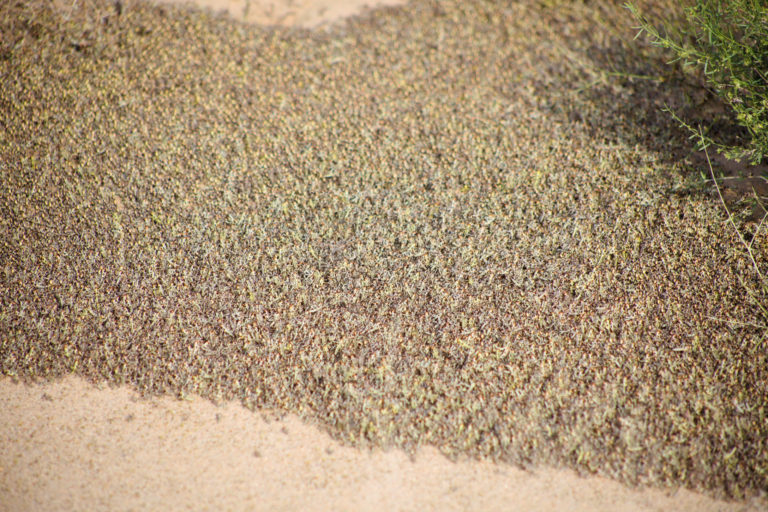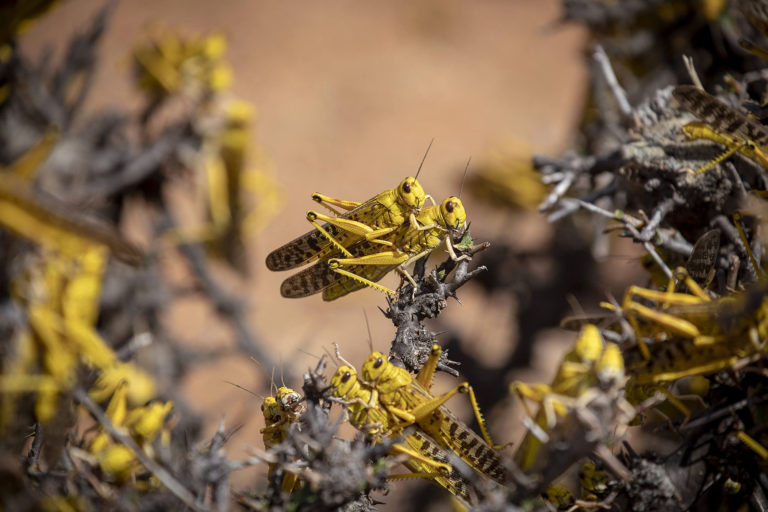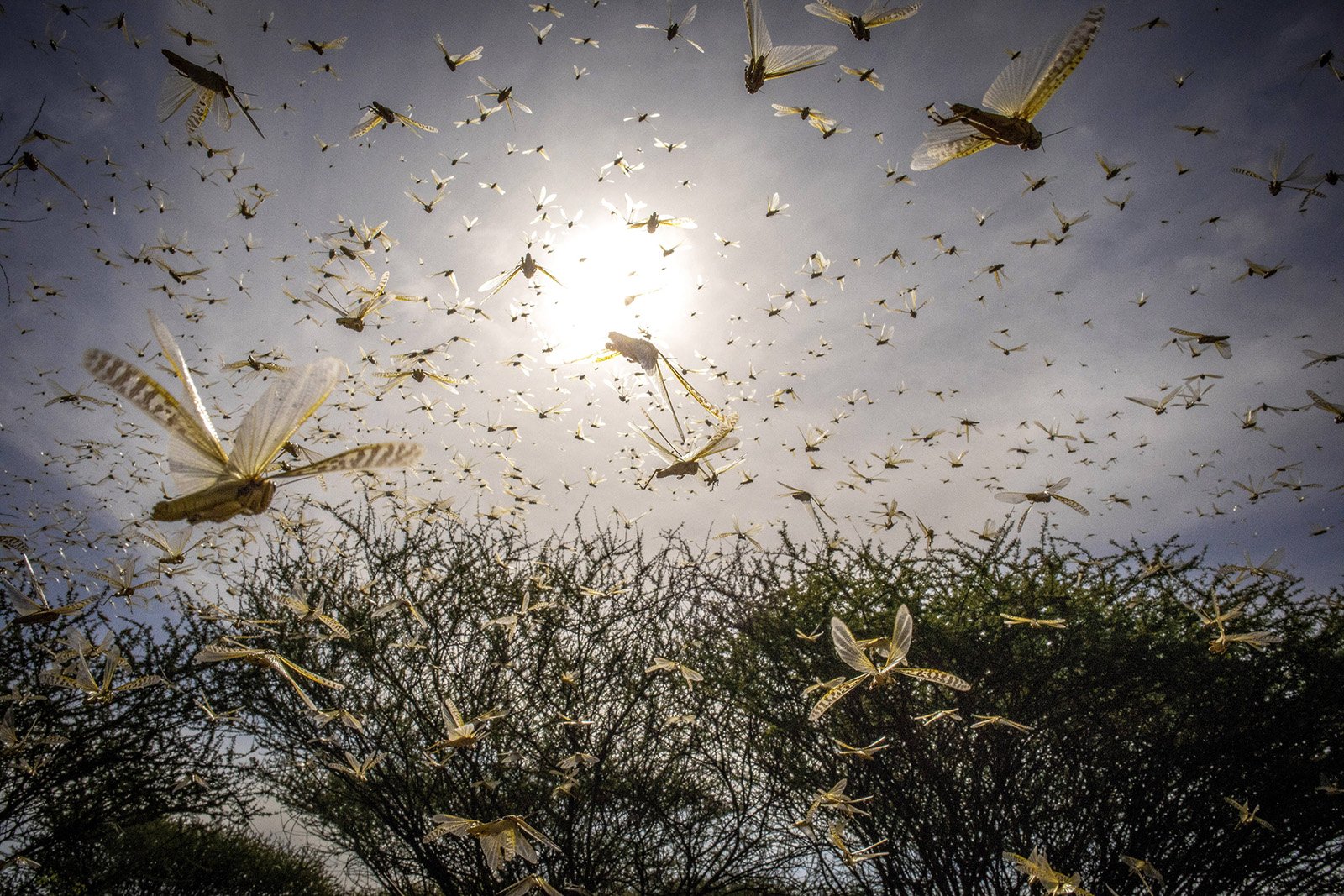With the on-going locust plague in East Africa of an unprecedented dimension in modern times, the region now faces a hunger threat. Action – and more funding – will be needed to avoid a major food crisis later, UN officials warned on 25 February 2020. This article by a top FAO expert provides necessary background information on locust plagues and how to fight them, pointing out that so far only 28% of the $76 million required to fight the scourge in Africa has been secured. He also makes the important point that a more “holistic approach” would be advisable, including adopting preventive measures and using locusts in agrifood and feed industries. (Editor’s Note)
Globally, locusts plague dates back to several millennia, especially in Africa, the Middle East, and Asia. Locust outbreaks have been generally known to be linked to climate change. Locust outbreak in West Africa in 2004 was valued at about US $2.5 billion, requiring US$122 million to control.
In a recent review of the desert locust (Schistocerca gregaria), by Le Gall and others, the records from Egyptian tombs as early as 2420 BC confirmed periodic locust devastation for several millennia. The review further showed that locusts are capable of covering 20% of the earth’s surface, affecting the livelihoods of a tenth of the global population.
A single swarm of desert locust can potentially affect 60 countries, and a single swarm can cover 1, 200 km2. It was also documented that upsurges of another type of locust (S. piceifrons) since 1611 affected every country in Central America with an average of 3-5 plagues per century thereafter. An anticipated outbreak of Peruvian locust (Chistocerca interrita) due to El Niño occurred in 2017, was successfully combated with preventative measures through monitoring and spraying of focal areas totaling 7,769 hectares in the region.
China has over 3,000 years of history of locust upsurges and plagues. Over 800 plagues have been recorded from 707 BC to recent times. In the earliest Chinese — script (Jiaguwen script) locusts inscribed on an ox bone in Oracle Script 3,500 years ago, a question was anonymously raised, “Will locusts appear in the field; will it not rain?’” (Tian et al, 2011). This record clearly links climate with locust invasion.
For instance, between 23rd century B.C. until A.D. 1911, more than 8,000 locust occurrences were recorded. Plagues occurred nearly every 9-11 years, nearly half of the years in most centuries. The Chinese experience showed that bye-laws were passed compelling people to catch locusts and bury them in pits (Wang et al. 2003).
An ancient Chinese poem on locust outbreaks during the Tang dynasty (618-907) captured the extent and control vividly (by Juyi Bai):
“Locust outbreaks distributed widely in the center,
Eating like silkworms and flying like rain,
Green crop shoots disappear,
Only black soil left for thousands of miles,
Governors worried about yield,
Demand that people catch locusts day and night.”
In July 2008, when the locust swarm infested 5,000 square miles in China, the government deployed 200 tons of pesticides, four aircrafts, 50 new large-scale aerosol sprayers, and 100 000 small-scale sprayers to knock down the locusts. In that intervention, more than 33 000 locust exterminators were dispatched to battle the infestation in northern China.
Chemical pesticides have been mostly used in the past but in recent years targeted bio-pesticides (non-chemical) are becoming increasingly used to control locusts. According to Zhang (2017), compared to 5% in 2004, China sprayed biopesticides in 30%, of treated areas estimated at 100,000 ha per year. This surpasses the amount used in the rest of the world put together.
Farmers have beaten down locusts, threw objects, used fires and smoke, and hand-picked to catch as much as they could to supplement their diets, but these efforts have been so far futile.
Currently, the desert locust is spreading and unleashing mayhem in the Horn of Africa. It is not the first time, nor will it be the last, regardless of what efforts are put in place to control and prevent, history shows us that we can at best push forward another plague.
Various approaches have been used to prevent and control locusts. Farmers have beaten down locusts, threw objects, used fires and smoke, and hand-picked to catch as much as they could to supplement their diets, but these efforts have been so far futile, as the unfortunate case of Madagascar shows. They were too low to make a dent on the locust swarms.

Locusts are harmless when solitary, but become voracious when they congregate in groups and become more abundant. Photo Credit: ©FAO/Isak Amin.
What Options Are Most Feasible?
Hundreds of billions of dollars have been spent on control and prevention of locusts in the last few centuries. There is consensus that the immediate, most feasible option to rapidly get rid of the locust infestation is certainly through spraying, especially biopesticides.
In 2013, when more than 60% of the 13 million Madagascar population were affected by locust, about 2.3 million acres of farmland were sprayed with pesticides. Through three successive years of campaigns, with a total estimated budget of $41.5 million, with the help of FAO, the government and partners the situation was finally brought under control.
Likewise, FAO is currently helping countries in the Horn of Africa deal with the current upsurge to avoid further catastrophes in the region. This involves sprayers and larger equipment that can be mounted on vehicles and aircraft to rapidly knock down the pests. Early this month five low flying planes were reported to be spraying in Kenya. FAO has ordered 4 tons of the Metarhizium biopesticide, enough to treat about 80,000 hectares. So far, only 28% of the $76 million needed has been secured, and more is needed.
Massive Integrated Solutions at Scale
While the simple options of catching locusts or integrated management per se, cannot merely resolve the immediate situation unless that could be done at massive scale and speed, there is a need for a more holistic approach to the global locust challenge. In situations where sprays of biopesticides are not immediately feasible, innovative and integrated solutions could be deployed at a massive scale.
- Preventive measures. This should be employed for early detection through surveillance and monitoring, and rapid target of nymphal bands. This can be sometimes tricky as locusts often elude surveillance by reason of the remoteness of its breeding locations in the desert. This requires up to date equipment, infrastructures, and training.
- Post-outbreak control measures. The post-outbreak campaign and control measures are the interventions that often get the headlines and tend to work better for raising the funds. But as the old adage says, prevention is better than cure. With thousands of plagues and upsurges in history, locust control measures ought to now move towards integrated and environmentally safer solutions. The use of biopesticides is a move in the right direction and has helped to allay previous environmental concerns. But in addition to the two options above, there are other aspects that could be further explored.
- The humanitarian side of control. Considering the huge amount of resources that have so far, been sunk into control measures, largely by spraying pesticide sprays, there is a need to balance the efforts needed for humanitarian relief, and building the resilience of those affected along the value chain. Countries need to put in place effective policies and governance that strengthen social protection schemes, including insurance to farmers, producers, and local community dwellers. Most African countries have no insurance and protection schemes in their national budgets. This needs to be addressed.
- Explore the productive and innovative harvest and use of locusts.
Considering that locusts are large insects and can be available at massive enough scale to build any enterprise around, even for opportunistic use. History tells us that locusts are part of the biodiversity of this planet and they will not suddenly disappear. Locust is also an ancient food of mankind.
The question is how can we turn such a dangerous enemy — feeding on human food, into an important source of the food chain?

Locust as Food and Feed Source
Each time there is a plague or upsurge the headlines are quickly littered with breaking news, communities and governments are in a panic, and farmers mourn because they can easily anticipate the impending catastrophes. Yet, locusts are also part of human diets, and the protein supply in the world is inadequate, let alone other essential nutrients.
The question to ask is how can we turn a “lose-lose” situation to a “win-win”, or at least make the best out of a bad situation by generating nutrition and income from locusts?
Insects have been an important source of edible protein in many cultures. FAO (2013) has already documented the importance of edible insects including locusts. For instance, according to FAO, in South Africa, 20,000 km2 of mopane forests are reported to be worth US$ 85 million. This contributes to the incomes and livelihoods of rural producers, especially women. The locals are already used to eating locusts in Africa, the Middle East, and Asia. It is part of the food culture and even a delicacy in most places where they are found.
Super Food or Super Feed?
The search for superfood has been aggressive in the last decade. This might be a good opportunity to not only develop superfood from protein-rich locust but also a super feed for livestock and fish, pigs, pets and other domestic animals. Scientists have confirmed that locust meal exceeds the nutrition value of fishmeal. Balogun has shown that desert locust can substitute 25% of dietary protein in African catfish (Claria gariepinius) without reducing growth. Russian expert Oleg Kransilnik confirmed that the conversion rate of locust at 95% when used as feed.
Related Articles: Sustainable Agriculture | Two Flexible Financial Mechanisms
With their high feed conversion efficiencies, locusts are capable of converting high protein diets, carbohydrates and twigs and vegetation into body mass. As a result they are quite rich in proteins. They can transform low-value organic by-products into high-quality food or feed.
According to food tank, grasshoppers (and locusts) are superior to beef, not only in nutrition content. It has 72% protein, including essential amino acids. They also contain Omega-3, iron, zinc, Vitamin C, folic acid, B12, and chitin. They do not contain cholesterol or saturated fat, antibiotics, and hormones. These attributes suggest that locusts can be eaten, or used as food additives, animal feed, especially poultry feed and fish meal (aquafeed). Fish meal, in particular, is becoming increasingly scarce and expensive. This can be substituted or mixed with fishmeal to reduce the costs substantially.
Agri-Food Industrialist Offers to Buy Locusts
The challenge is that locusts are available in surplus—more than necessary for local communities to handle and use. But can we explore industrial harvest and turn these upsurges and plagues into effective use at scale? Of course, harvesting locust from the air and difficult landscapes will present another challenge that only technologies can address, but it is not unattainable.
Low flying helicopters, vehicles or drones mounting harvesting nests and traps can be developed. Also, means of drying and processing locust and the entire value chain need to be more developed. The starting point could be the agri-food industries that are already investing in insect farming expanding to wild harvesting.
There is good news for community dwellers in Kenya. On 19 February 2020, Kenyan billionaire industrialist, Peter Kuguru, has offered to buy and process locusts for animal feed as an important source of protein, vitamins, roughages, and minerals. At an offering price of Ksh 50 per kilo dried locust, he estimated that each person collecting 20 kg per day will make Ksh 1000, or over Ksh 25,000 a month.
At the end, nature has a way of adjusting, such that surges will be less destructive while biodiversity is maintained.
Harvesting locusts and scaling up its use in agrifood and feed industries may not solve all the problems of upsurge overnight, but it will make a dent on the ability of the pest to breed, multiply and devastate vast areas of lands. A critical mass of collectors are needed, and more food and feed business need to be developed.
Sustainability of locust in terms of supply in a period of recession will pose another challenge that farming insects can deal with, simultaneously.
Locust can be viewed as a low hanging fruit to scale up production at times of surges. Over-harvesting will result into recession in the long-run, but it is not a bad problem, at least to rural farmers whose livelihoods are being distorted. In the end, nature has a way of adjusting, such that surges will be less destructive while biodiversity is maintained.
Looking to the future
Integrated approaches for prevention and control of locust outbreaks should be an important part of the resilience and social protection systems of more vulnerable countries. This includes infrastructures, budget provisions, capacity development, and effective policies.
The importance of locust for food and feed security cannot be overemphasized, but it has so far, been poorly exploited.
Because of its sheer quality within a short period of time in the time of upsurges and plagues, agri-food industries should consider investing on a massive scale into harvesting locust for food, food supplements and feed for both poultry and aqua feed meal. This will require mechanical innovation in large scale harvesting and developing value chain of locust for food and feed products.
Editor’s Note: The opinions expressed here by Impakter.com columnists are their own, not those of Impakter.com — In the Featured Photo: 22 January 2020, Samburu County, Ololokwe, Kenya – A locust swarm takes to the sky in a recent upsurge in northeastern Kenya. The United Nations Food and Agriculture Organization (FAO) warned that the desert locust swarms that have already reached Somalia, Kenya and Ethiopia could spill over into more countries in East Africa destroying hundreds of thousands of acres of crops — Featured Photo Credit: ©FAO/Sven Torfinn









